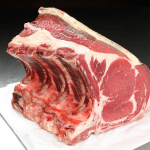How to cook A Bone in Fore Rib of Beef
If you want to know how to cook rib of beef, you need to appreciate that for many chefs, a bone-in rib of beef is the rolls-royce cut, and is their default choice for a roasting joint. On the bone, the ribs serve as insulation from the harsh heat of the oven and provide anchorage for the meat that prevents shrinkage. Cooked from room temperature, in a hot oven, the outside will char beautifully with a decent layer of golden fat, and the inside will cook to perfection with a little rare meat for those who like it, and the entire joint will flood with deep savoury flavour from the internal fat. No other joint has all of these qualities which point to the perfect roast. Here’s how to cook a beef rib roast.
Servings: 10
Instructions
- Prepare the rib of beef for roasting
- First you need to remove all the packaging and give the meat a good dry. You can do this by letting it stand uncovered, but it is quicker to use some kitchen paper. Then you need to leave it out of the fridge to come up to room temperature. When beef goes through the aging process it is the work of enzymes that improve the texture and flavour; by leaving the joint out and uncovered you are giving those enzymes some time to relax which gives them more chance of working their meaty magic, giving you a lovely succulent joint when roasted.
- Calculate cooking times
- Before you start to cook a rib of beef, you need to do a little bit of prep and research first, and work out how long you need to cook it for. To do this you need to know the weight of the rib joint. You need to calculate the cooking time by allowing an initial 20 minute blast on a high heat (220℃) and the 20 minutes per 500g for medium, 15 minutes per 500g for medium-rare, and 10-15 minutes for rare, at 170℃. Our advice is to go for medium or medium rare when cooking at home as this way you’ll have some well-done meat for those who like it that way (usually the kids), on the outside and some pinker meat towards the centre of the joint, meaning that all bases are covered. If you have a fan oven the temperature will need to be reduced usually, a reduction of around 20℃ is required but every oven has its own idiosyncrasies.
- Preheat the oven to 220℃/gas mark 7
- Give the layer of fat on top a good seasoning with salt and pepper, and a nice tip is to rub it with English mustard powder so that it cooks to a lovely golden crust.
- Pop the meat on a roasting tray, standing on its end with the ribs pointing skywards. Due to the height it will probably need to go on the bottom shelf of the oven. Give the beef a 20 minute sizzle in the high oven at 220℃/gas mark 7 then turn the oven down to 170℃/gas mark 3 and time the cooking of the joint from this point.This really gets the browning process started and the caramelisation of the surface on its way.
- You should try and weight the joint yourself, but an average size two bone rib of beef is approx 2.5kg so you could use the timings below for this size• 1 hour 15 mins at 170℃/gas mark 3 for MEDIUM RARE• 1 hour 40 mins at 170℃/gas mark 3 for MEDIUM• 2 hour 5 mins at 170℃/gas mark 3 for WELL-DONEFor a more accurate doneness you want to use a meat thermometer and you’re looking for an internal temperature of 50℃ for RARE 60℃ for MEDIUM 70℃ for WELL DONE
- If you don’t have a meat thermometer then the redder the juices, the rarer the meat. For a medium roast you can expect a flow of clear juices mixed with a little pinkish blood. You could also press the meat but for a joint of this size you will need to press from both sides. The more spring in the flesh, the rarer it is. The perfect medium joint will feel quite taut, with just a small amount of spring radiating from right in the centre. Don’t forget that the meat will continue to cook as it rests, and the juices will also become more evenly distributed, so don’t leave it cooking too long.
- When it is cooked, you need to let it rest for at least 20 minutes.This step is non-negotiable, and is essential to allow the meat to relax and distribute the juices evenly, and it will also allow you time bring the rest of the meal together and free up the oven for the roastes etc.
- How to carve a rib of beef
- Although your meat will be tender however you choose to carve it, rib of beef is best when carved reasonably thin, when the rib of beef is cooked and rested, stand the joint so the ribs are pointing upwards• Position a sharp carving knife (or your biggest knife) between the top of the ribs and the meat• Keeping the knife pushed against the ribs, gradually cut along the bones to release the meat from the ribs• Keep going until the ribs are released and removed. You can use the ribs to add flavour to gravy or stock if you are making some.• Hold the meat with one hand, and thinly slice the meat as thinly as you can across the grain.• It is generally better to only carve what is needed as the beef will keep better for leftovers as a single piece.Serve with whatever you think is best, but it will almost certainly involve gravy, Yorkshire puddings, horseradish sauce, roast potatoes and some vegetables.

